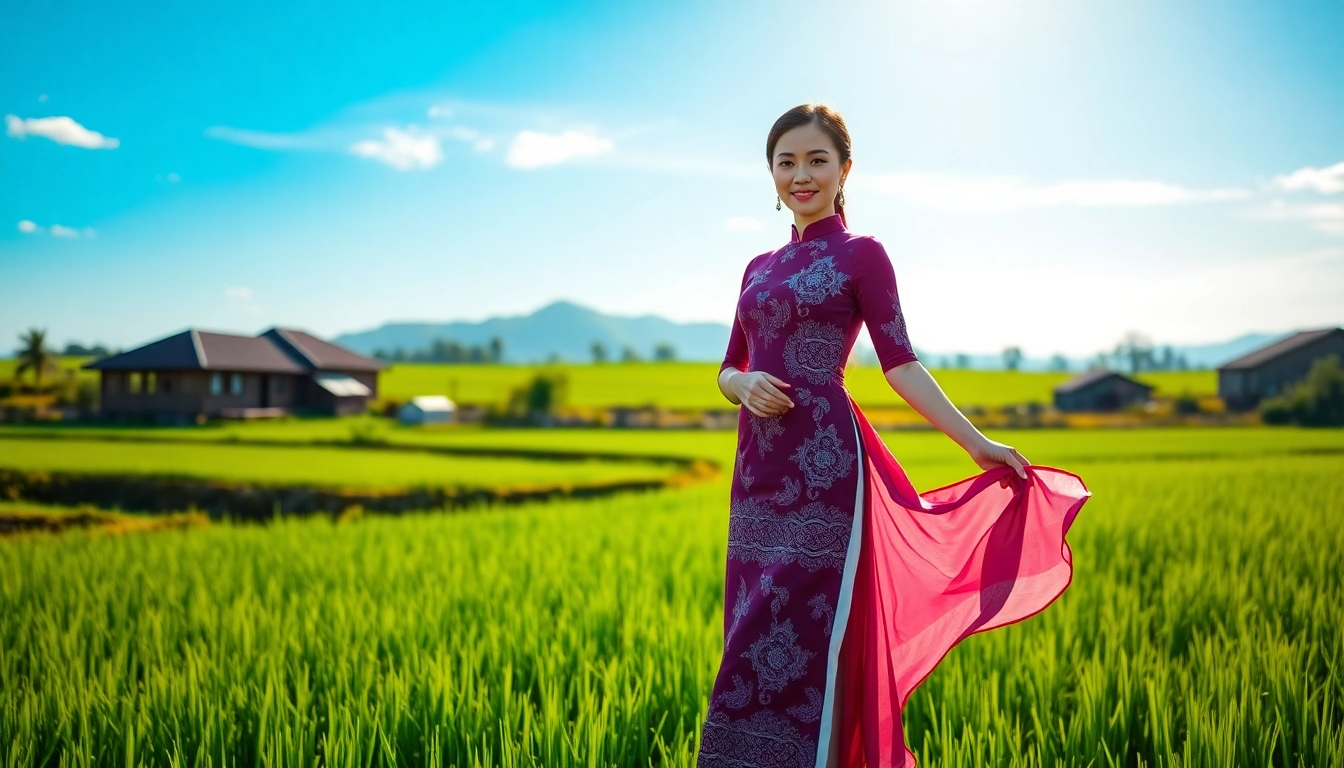Introduction to Vietnamese Áo Dài
The Vietnamese Áo Dài is more than just a garment; it is a symbol of cultural heritage, elegance, and national pride. Revered as Vietnam’s traditional attire, this exquisite outfit blends fashion with history and identity. The Áo Dài is known for its long tunic that gracefully drapes over intricately tailored pants, embodying the beauty and grace of Vietnamese women. This article will delve into the nuances of the Vietnamese Áo Dài, highlighting its historical significance, key features, cultural impact, and styling tips for the modern wearer.
Throughout this exploration, we will focus on the evolution of the Vietnamese Áo Dài, its role in contemporary society, and how it continues to reflect Vietnamese values. To learn more about the cultural importance of this iconic outfit, dive into the world of Vietnamese Áo Dài and its place in fashion and tradition.
Historical Significance of Vietnamese Áo Dài
The history of the Vietnamese Áo Dài is rich and multifaceted, tracing its origins back to the 18th century during the Nguyen Dynasty. Originally, the garment was a two-piece ensemble that consisted of a loose-fitting, long-sleeved blouse and trousers, inspired by various cultural influences, including Chinese and Cham designs. Over the years, the design evolved in response to societal changes, art, and fashion trends.
Roots in Royalty and Tradition
Initially, the Áo Dài was worn by both men and women of aristocratic backgrounds, often made of luxurious silks and adorned with intricate embroidery that signified status. The garment’s silhouette began to take shape as it became associated with femininity during the late 19th and early 20th centuries. This shift was marked by the introduction of high slits on the sides of the tunic, allowing for greater mobility while accentuating the figure of the wearer.
Political and Social Influences
Throughout the years, the Áo Dài has been a canvas for political expression. During the French colonial period, it became a symbol of resistance and cultural pride among the Vietnamese people. The outfit continued to evolve after the reunification of Vietnam, where it became a symbol of national heritage and pride, with many women donning the Áo Dài on special occasions and public ceremonies.
Evolution of Vietnamese Áo Dài through the Ages
The transformation of the Vietnamese Áo Dài reflects broader shifts in Vietnamese society, art, and fashion trends. From traditional forms to contemporary adaptations, the Áo Dài has adapted without losing its essence as a cultural icon.
Traditional to Modern Design Evolution
The traditional Áo Dài is characterized by its simplicity, elegance, and use of natural fabrics. Traditionally, cotton and silk fabrics were favored, providing comfort and breathability. However, with modern design influences, the Áo Dài has embraced a wider variety of materials, including synthetic fabrics, making it more accessible and versatile for everyday wear.
Influence of Global Fashion
Global fashion trends have also influenced the design and styling of the Áo Dài. While retaining cultural motifs and designs unique to Vietnam, new patterns, colors, and cuts have been introduced to create the современная Áo Dài, appealing to younger generations and international markets. The acceptance of bold colors and contemporary silhouettes has revolutionized the way the Áo Dài is perceived and worn today.
Modern Interpretations of Vietnamese Áo Dài
In contemporary fashion, the Vietnamese Áo Dài has transcended its traditional boundaries. Designers actively experiment with styles, making the Áo Dài a versatile choice for various occasions, including weddings, fashion shows, and international events.
Contemporary Designers and Innovations
Prominent fashion designers in Vietnam are breathing new life into the Áo Dài, showcasing it on runways not only in Vietnam but also across the globe. By incorporating unconventional materials and modern aesthetics, they are creating innovative designs that resonate with both local and international audiences. This reimagining keeps the garment relevant in today’s fast-paced fashion world.
Celebrity Influence and Cultural Representation
Vietnamese celebrities often wear the Áo Dài at public events, reinforcing its status as a cultural emblem. This visibility allows the garment to maintain its prominence in the fashion landscape while eliciting pride among the Vietnamese community. Social media also plays a significant role in popularizing the contemporary Áo Dài, allowing fashion enthusiasts to share their unique styles and creative interpretations of this traditional attire.
Key Features of Vietnamese Áo Dài
Understanding the essential components of Vietnamese Áo Dài is crucial to appreciating its beauty and significance. Several key features define the Áo Dài, making it unique among traditional garments.
Design Elements and Fabrics Used in Vietnamese Áo Dài
The Áo Dài’s design is distinguished by its form-fitting silhouette, high collar, and side slits that extend up to the waist or higher. These elements not only create an elegant appearance but also promote ease of movement, showcasing the gracefulness of the wearer. The choice of fabric greatly influences the garment’s overall look and feel. From luxurious silks, which offer a soft drape, to brocade and lace, the variety of materials allows for diverse interpretations of the Áo Dài.
Color Symbolism and Cultural Importance
Colors carry significant meanings in Vietnamese culture, and the Áo Dài is no exception. Traditional colors like red and yellow are believed to bring good fortune, making them popular choices for celebrations and auspicious occasions such as weddings and Lunar New Year. Conversely, cooler tones are often associated with formal events or solemn occasions. This connection between color and meaning enhances the garment’s cultural relevance.
Variations of Vietnamese Áo Dài for Different Occasions
Different occasions call for different styles of Áo Dài. There are variations specifically designed for festive occasions, weddings, and even daily wear. For instance, wedding Áo Dài are often made from luxurious materials, embellished with embroidery and intricate detailing, while everyday versions might favor more casual fabrics and simpler designs. Understanding these distinctions helps individuals choose the appropriate style for their intended purpose.
Cultural Impact of Vietnamese Áo Dài
The Vietnamese Áo Dài does not only represent personal style; it holds a profound cultural impact that resonates throughout Vietnamese society and beyond. Its cultural significance extends to festivals, artistic expressions, and representation on global platforms.
Representation in Vietnamese Festivals and Ceremonies
The Áo Dài plays a fundamental role in various cultural festivals and ceremonies within Vietnam. It is especially prominent during Tet, the Lunar New Year, where people wear new Áo Dài to welcome the new beginnings. In educational settings, school festivals often see students donning their Áo Dài, promoting cultural pride among younger generations. This constant presence in important events cements its significance as an embodiment of Vietnamese identity.
Global Recognition of Vietnamese Áo Dài
As the world becomes more interconnected, the recognition of the Vietnamese Áo Dài has extended beyond Vietnam’s borders. The garment has gained admiration in fashion circles, appearing in international fashion weeks and events dedicated to cultural appreciation. This exposure illustrates how the Áo Dài serves as a bridge between cultures, fostering understanding and appreciation for Vietnamese heritage.
Influence on Fashion and Artistic Expression
The Áo Dài’s design and style have also influenced fashion beyond its traditional confines. Artists and designers worldwide draw inspiration from its elegant silhouette and intricate designs, reshaping them through various interpretations in contemporary fashion. This creative dialogue highlights the Áo Dài’s enduring legacy and its role in influencing fashion trends globally.
Wearing and Styling Vietnamese Áo Dài
Understanding how to wear and style the Vietnamese Áo Dài is essential for both first-time wearers and those looking to refresh their look. The right ensemble can showcase the outfit’s beauty while expressing personal style.
Best Practices for Choosing the Right Fit
Selecting the correct fit is vital to ensuring a polished appearance in the Áo Dài. The tunic should be fitted but not overly tight, allowing for comfort and fluid movement. It is important to consider body shape and proportions when choosing size, as the design of the Áo Dài should enhance the wearer’s natural silhouette. Tailoring is often a preferred choice to achieve a perfect fit, ensuring the garment flatters the wearer’s figure.
Accessorizing Your Vietnamese Áo Dài
Accessorizing can greatly enhance the overall look of the Áo Dài. Traditional accessories, such as silk scarves, embroidered bags, and statement jewelry, can add a personalized touch while maintaining cultural relevance. Additionally, choosing the right footwear is key—traditional flat sandals or modern heels can both complement the outfit depending on the occasion. A delicate hairpiece or traditional conical hat (nón lá) can complete the look, evoking cultural pride.
Tips for Caring and Maintaining Your Áo Dài
Caring for your Áo Dài is essential to maintaining its quality and appearance. Most garments require gentle washing, preferably by hand, to protect delicate fabrics. Storing the Áo Dài in a cool and dry place, without folding it in a way that might distort its shape, will help preserve its design. It’s advisable to use a fabric steamer to remove wrinkles, as direct heat from ironing may damage the fabric. By following these care tips, wearers can ensure their Áo Dài remains beautiful for years to come.
Conclusion: The Timelessness of Vietnamese Áo Dài
The Vietnamese Áo Dài stands as a timeless testament to cultural identity, elegance, and the deep-rooted traditions of Vietnam. As it continues to evolve, integrating modern styles while staying true to its historical roots, the Áo Dài remains a cherished garment that embodies the spirit of the Vietnamese people.
Celebrating Vietnamese Heritage and Identity
Embracing the Áo Dài is not just about wearing a beautiful outfit; it is about celebrating and honoring Vietnam’s rich heritage. In a rapidly changing world, the Áo Dài serves as a beautiful reminder of cultural continuity, inspiring pride and commitment to Vietnamese traditions.
The Future of Vietnamese Áo Dài in Fashion
As global fashion trends continue to evolve, the future of the Vietnamese Áo Dài appears bright. With ongoing innovations and an expanding audience, the Áo Dài will remain an integral aspect of both traditional and modern wardrobes. The demand for culturally significant and versatile clothing ensures that the Áo Dài will continue to thrive.
Encouragement to Embrace Vietnamese Áo Dài
In conclusion, embracing the Vietnamese Áo Dài is an invitation to honor culture, express style, and connect with one’s heritage. Whether worn during celebrations, daily life, or special events, the Áo Dài serves as a binding thread that weaves together the past and the present, ensuring its relevance and beauty in the future.



